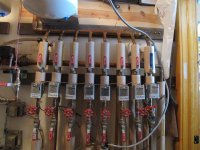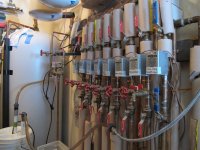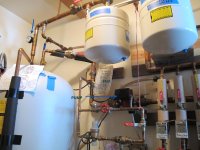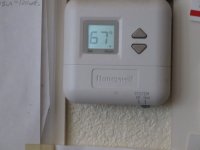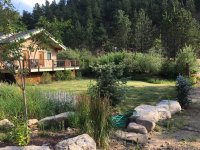Can you elaborate on this a bit?
Is your floor heat thermostatically controlled?
If so, do you use a probe in the concrete?
What is your primary heat source?
Why won't your heated floor heat the house?
Sure, glad to.
The heat source is nothing more than an electric 50 gallon Hot Water Heater filled with half water/half propylene glycol. I chose a Marathon brand because they have a fiberglass/epoxy body and won't rust.
This type of heat is simple and cheap initially, but does cost electricity. It wouldn't be reasonable longterm where electrical costs are high because an electric HWH doesn't put out many BTUs compared to a natural gas or propane boiler. It is a darn good way to get up and operating though....
So although these hydronic floors we built would be up to the task if they were carrying warmer water, the HWH itself just won't keep up. An on-demand type hot water heater run off nat gas or propane would probably be a good compromise between what I have and a real boiler like the Munchkins.
Remember, we built using the cash we made as we built. Didn't want a loan or debt. So we built with alternatives.... the HWH was cheap to install, but I also plumbed in some extra fittings fluid fittings, along with a propane line (capped) and a outside vent all into the utility room so we can put a real boiler in there any time we want. It would only take an afternoon. So far, this works OK.
Yes, there are 8 zones in the house - all come off of the central manifold you see in the first photo. The zones are balanced for resistance by making each zone have the same length of heating pipe buried in the cement . The main room of each zone has a simple thermostat placed on the wall of the main room in that zone. Each thermostat then controls its own electrically-operated on/off flow valves which you can also see in the photo of the zone manifold. And since I like to tinker, each valve also has a manual over-ride so I can take any zone out of the system without affecting the rest.
Each thermostat can call for flow or not - or I can override it. Note that the zone manifold itself is simply made of plumbing fittings soldered together. Making up the manifold one weekend saved a few grand right there.
The pump for the whole system runs continuously any time any thermostat is calling for heat....it seems completely sufficient - which surprised me since doesn't run any faster or slower if all eight zones want heat at the same time. I've included a photo showing the pump. It is very small and quiet.
Any hydronic system is slow to change temperature and this one even more so. There's a lot of mass and not many BTUs. There's advantages to that. And one of those advantages to a low heat hydronic is that the floor and walls and room air are all about the same heat give or take a degree or two. So a simple cheap wall thermostat works fine for temperature control.
HOW DOES IT WORK??
Today it is about 20F outside and the system easily keeps the house at 67F with the HWH running all the time and creating hotwater/glycol that I control to be 110F . But that's about its limit. If it drops to zero tonight, the house will drop into the low 60s inside. And no matter how warm the winter day - say it is is 60F outside, this system will only push the room heat up to somewhere in the high 70s.
I do have two areas in the house (center of living room and kitchen) where I poured the concrete floor an inch lower so I could install a thin hardwood floor with the heat pipes directly beneath the wood. That was to be my "fast reacting" hydronic heat. But after all that effort, it is not noticibly any faster or slower thatn the rest of the floor. Looks nice, though...
This one was a winner, and hats off to the old plumber "Bertie" who helped me lay out the piping and find the best buys on material. He didn't believe that a HWH would work, but was willing to try as long as I also plumbed to accessory inputs "just in case". And I'll admit is part of the reason a HWH works as well as it does is because the house if built very heavy and well insulated as is typical in a cold climate. So far it has run for 15 years without any maintenance at all of any kind. In the winter my $150 monthly electrical bill can climb up to the $450 to 500 dollar/month range if I use the floor for all the house heat. Maybe half that much if I run the wood stove in the living room. It pretty much heats 2/3 of the house all by itself.
Bottom line is some things you try work and some don't.... But this system is excellent. I'd do it exactly the same way again.
rScotty
